Staffs contractor rates Shelbourne’s ‘head memory’ hedgecutter
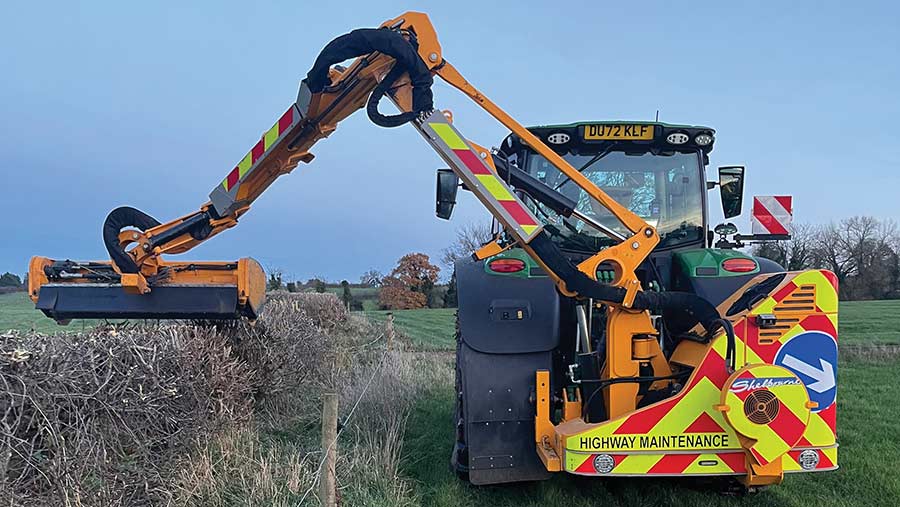 © MAG/Oliver Mark
© MAG/Oliver Mark Crafting a pitch-perfect hedge is an art many attempt but not all master.
Thousands of tiny tweaks must be made to keep the flail head at the desired angle as the boom is raised and lowered to account for the rise and fall of the tractor on which it is mounted.
But a sizeable number of those inputs can now be eliminated with a neat system available on Shelbourne Reynolds’ top-of-the-range 8000-series trimmers, which automatically maintains the head angle irrespective of arm movements.
See also: How to get the best from a McConnel hedgecutter

© MAG/Oliver Mark
After more than 40 years of hedge taming, and an arthritic hand and wrist as a result, Staffordshire contractor Mike Tomlinson was keen to cut out some of the repetitive strain involved in his 1,200 annual hours of bushwhacking.
For the past three years, he’s been working with Shelbourne to develop its “head memory” system.
And, after some 3,500 hours of trial work, a dozen different sensors and umpteen ECU rewrites, it’s finally available as a £1,175 option on new machines.
At the heart of the kit is a small gyroscopic sensor – effectively an electronic spirit level – mounted in a black box behind the cutting head.
Mike Tomlinson’s Shelbourne Reynolds 8065 VFRT
- Max reach 6.5m
- Head 1.6m HC 1600
- Hydraulic power 85hp
- Weight 2,200kg
- Min tractor power/weight 130hp/5,500kg
- Controls S-Touch Max joystick and touchscreen
- Extras Debris blower, hydraulic nose and roller, highway kit, axle bracket and sub-frame
- List price £61,673
- Approx on-farm price £48,000
This constantly monitors the working angle, with the information relayed to the trimmer’s ECU.
This, in turn, controls the hydraulic valve block, tweaking the rams to keep things consistent.
In practice, the operator can either select one of two preset head angles on the S-Touch Max touchscreen terminal in the cab – either a 0deg horizontal cut, or 90deg plumb.
Alternatively, users can set and store a particular angle or use the “variable” mode, whereby the head is simply positioned by working the joystick rocker.
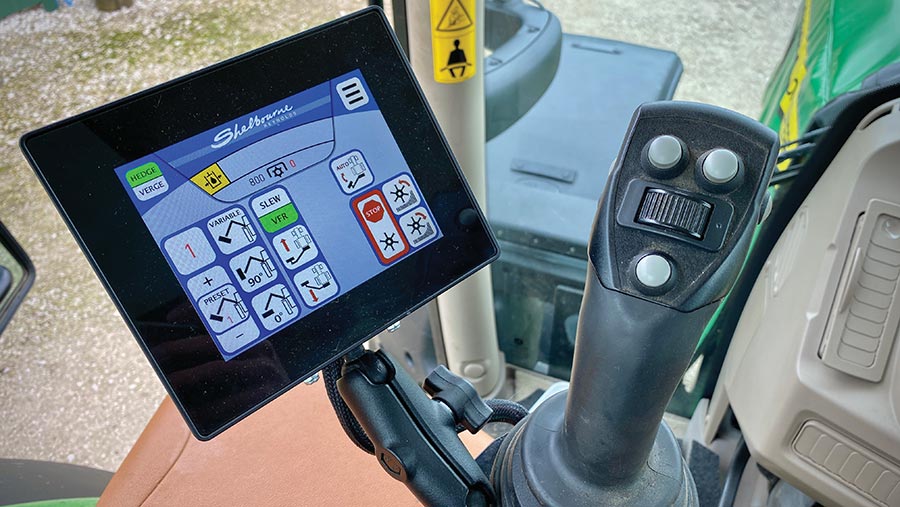
© MAG/Oliver Mark
Mike prefers to work with the latter as it allows him to quickly and easily alter the position on the move.
But, no matter the mode selected, the system will maintain the cutting angle as the boom position changes, saving thousands of corrective movements with the joystick.
Reduced operator input
The system has vastly reduced repetitive wrist movements and the amount of operator input required, says Mike.
“Hedgecutting is tedious at the best of times, but this has basically halved the number of controls I have to worry about when I ride over a bump or the pitch of the tractor changes.
“Rather than correcting the trimmer head every time I move the boom, I can simply reposition the arm and the head will counteract any changes accordingly.
“It’s one less thing to think about and saves my thumb no end of work.”
Aside from reducing the effort on the part of the operator, the other benefit comes in topping a hedge far taller than the tractor.
Even with a trained eye, it can be hard to judge and adjust the angle of the flail in such situations.
“Many a time I’ve thought I was making a straight cut only to subsequently find that it wasn’t quite square.
“With this, it’s reassuring to know it’ll be bang-on first time. It takes a bit of skill out of the job, just like tractor guidance systems, but as with GPS, once you’ve tried it you don’t want to go back.”
When demonstrated in the yard, the automated head movements look a little jerky and delayed in response to any change in the boom position.
But, says Mike, they’re near imperceptible in work when tweaks are often just a few centimetres one way or the other.
And if it’s not quite set to the operator’s liking, there’s plenty of scope for adjustment through the 6in touchscreen, including altering the speed at which the head reacts to changes in its pitch.
The 0deg horizontal position can also be recalibrated without any manufacturer input.
Replacement incoming
The 8065 VFRT (variable forward reach telescopic) on which the system was tested is set to be replaced this year, with a new model due for delivery in July.
This will also have the “head memory”, along with a raft of other optional extras.
“Two years is the sweet spot in terms of replacements,” says Mike.
“It’s still a desirable machine that plenty of punters are willing to pay decent money for, but stretch it to three [roughly 3,500 rotor hours] and that market shrinks considerably, so the depreciation hits much harder.”
In his two years of ownership, prices have risen by about £3,000 like-for-like, which inevitably brings his charge-out rates into focus.
As a result, he decided to gradually ease back on agricultural work, which currently accounts for about half of his annual hours – but significantly less of his profit.
“Farms generally don’t want to pay what it costs to cut hedges.
“So, if you’re willing to take on the risk assessments, method statements and switch between red and white diesel – which I did 14 times last year – then you can do far better working on industrial and amenity sites.”
“They pay twice my agricultural rate – which is £45/hour plus fuel [typically £10/hour] – and it’s the only way of affording to run decent kit.
“I know there are people charging as little as £30/hour. But that barely warrants a five-year-old trimmer on a tractor of similar vintage, let alone the near £20/hour depreciation of a Fendt, plus cost of the fuel, driver and the machinery to start with.
“In my view, it should really be nearer £100/hour. It’s unrealistic, I know, but farms are getting paid to do stuff with hedges and some of that money should be passed on to the contractor.”
Customised outfit
Mike runs his hedgecutter on a John Deere 6R 140 tractor, which he has lightly modified to gear it up for the job.
For starters, it runs on a set of Nokian Ground Kings, which are kinder on the ground than standard tractor tyres and travel far smoother on the road.
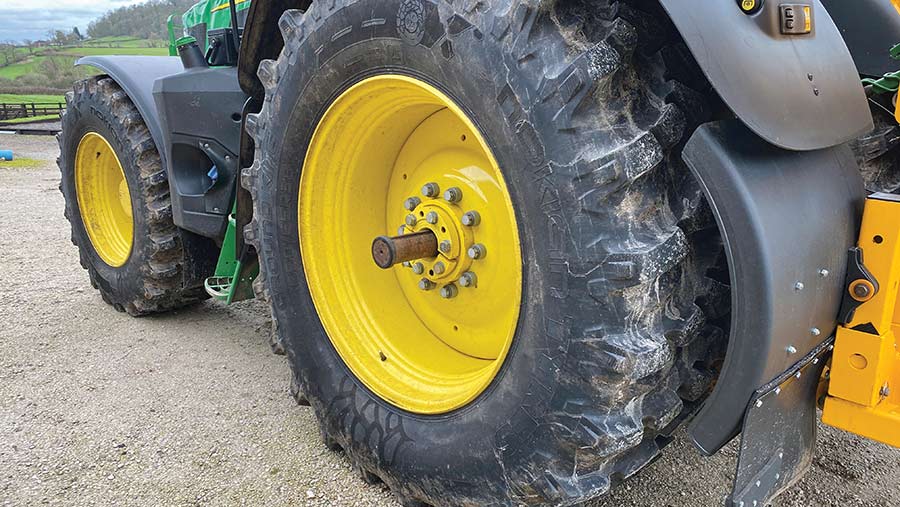
© MAG/Oliver Mark
For the summer season, from July to October, they’re switched for Nokian Tri 2s, a grass-industrial rubber that he reckons should last for about 9,000 hours.
Behind the front wheels he’s fitted Kramp fender extensions (£35 apiece) and at the rear are his own home-made guards that attach to the trimmer rather than the tractor.
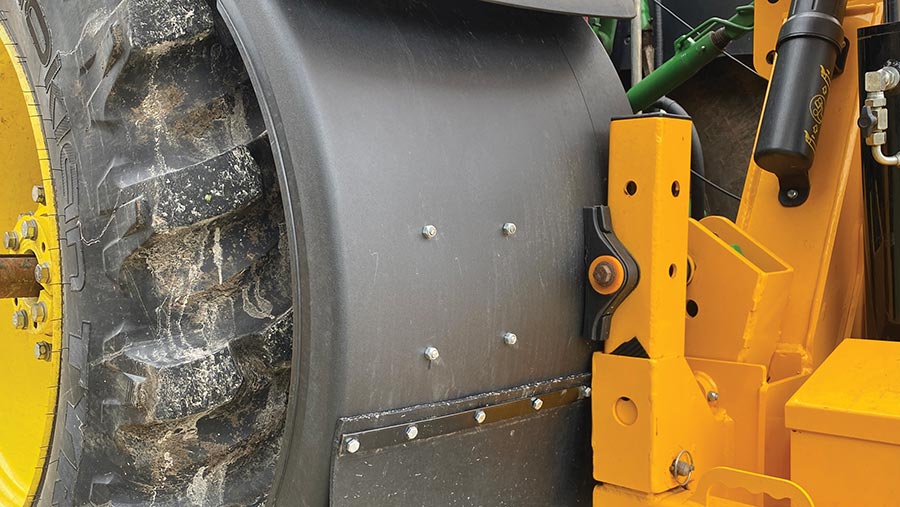
© MAG/Oliver Mark
The upper section is a standard half mudguard, to which he has bolted HGV Direct mudflaps.
These are attached to the main frame by mounting brackets that house bushes from the suspension of an old Land Rover.
He has also found a natty way of eliminating the slop in the axle mounting bracket, which tends to be more pronounced on John Deere tractors due to their linkage geometry.
Rather than fitting standard spacers that would make it awkwardly tight to couple up, he instead slots a spanner into the void that can be easily removed when uncoupling.
Other extras include a half-tonne Agriweld weight block for the front, a Cab Cam reversing camera on the back, and a flashing beacon atop the arm pivot to help car drivers spot him over the hedge line.
Debris protection comes by way of a Cunningham Covers PVC bonnet guard that matches the tractor’s paintwork and decals – a £350 addition – and laminated cab glass that was a £40 option when he bought the tractor.
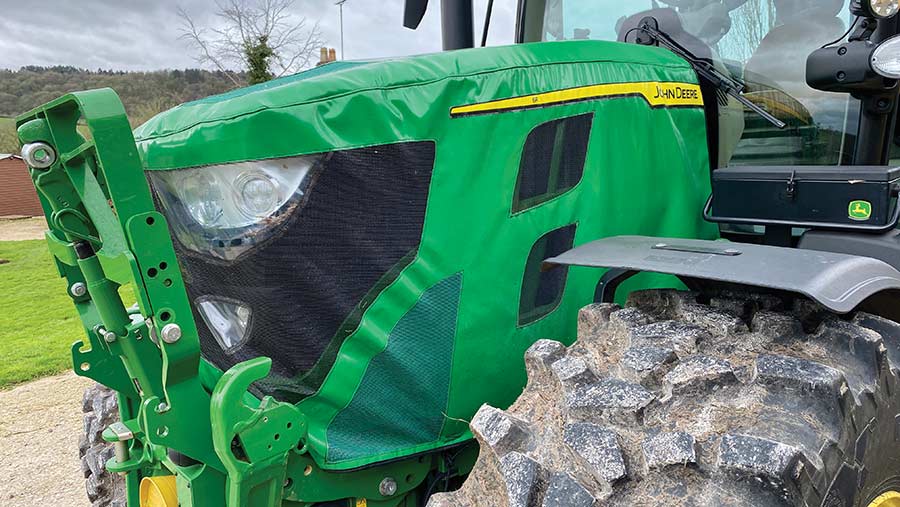
© MAG/Oliver Mark
“I’ve tried all types of door glass protection, but I can’t bear to look through it all day,” he says.
The one problem with the 6R is the design of the fancy wing mirrors, with the one-way clips that latch the glass meaning the green plastic shell has to be smashed to replace it. As a result, replacements cost £420 a go.
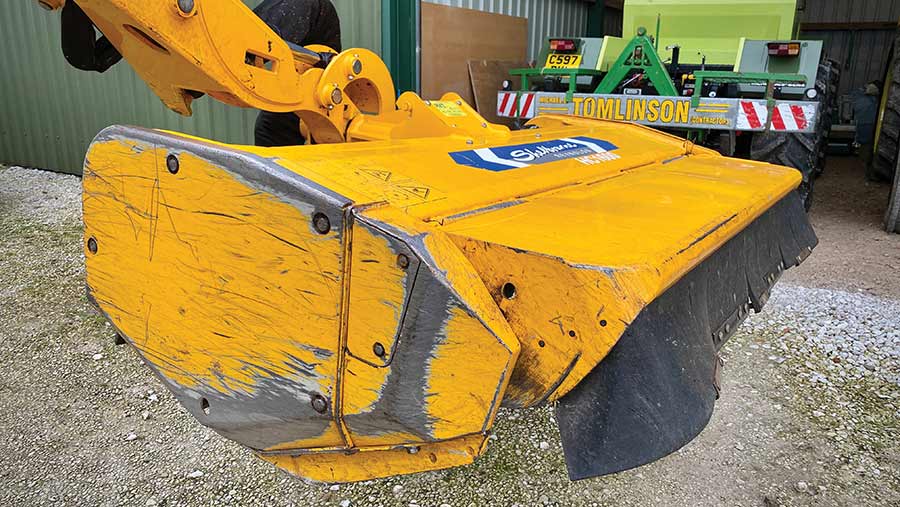
© MAG/Oliver Mark
Mike also has a second cutting head, as an alternative to Shelbourne’s 1.6m HC 1600 (high capacity) flail.
The Major HC143 has a Shelbourne mounting bracket, meaning it can be coupled up with minimal fuss.
Its twin rotors, each with four blades, are particularly effective when attacking evergreens, with the body designed to push cut material into the hedge and prevent debris falling onto the road.

